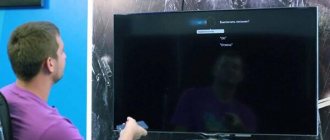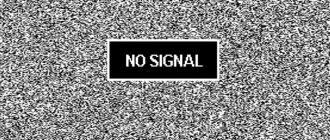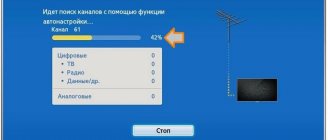If Telekart satellite broadcasting channels have disappeared, city residents are not very upset. However, at the dacha this may mean a complete lack of entertainment or a guaranteed miss of your favorite show. The telecard does not show some channels or all broadcasts for several reasons. Some of them can be eliminated yourself. To understand what to do, you need to take your time and analyze possible sources of problems consistently.
Why doesn't TV Telecard show?
Satellite TV is one of the most reliable signal transmission technologies: you are not dependent on city cable networks or Internet connection failures.
But still, sometimes it stops working. What to do in such cases? Of course, if finances allow and there is a proven master, it is better to call him. You can also call the operator's technical support number. But most problems can be easily classified and fixed on your own.
You can read about the most common problems due to which Telecard satellite TV may not show, and how to neutralize them, in this article.
GLOBO receivers
In this equipment, updating the list of TV channels will take place in a similar way.
- First we go to the menu.
- After this, you must select “Custom Settings” and confirm your action.
- Go to the sub-item “Reset to factory settings” and confirm the action. As in the previous case, the system will ask you for a password.
- After this, in all pop-up windows you must click on the “OK” button.
- Finally, click on the “OK” button, after which you can exit the settings.
Additional equipment includes receivers. In these receivers, the first 4 points are very similar, but then there are some changes. How to update channels on Telecard? First, go to the menu, select the “Settings” item and go down to the “Factory settings” sub-item, then enter the password. Turn on “Network Search”. Next, turn on the “Search for channels” item and wait. The search will last about 20 minutes and will find all the necessary channels. At the end, you need to click “OK” and exit the settings.
If you do not find your receiver in the list of recommended equipment, then it is not recommended to use it with the Telecard operator. However, you can connect unsuitable equipment, but the setup will be slightly different. How to update the channel list on Telecard?
- Turn on the receiver and TV, go to the menu. You should immediately check the settings of your receiver. The master, when connecting a package of TV channels, could simply enter the name “Telecard”, but use a different satellite. Go to “Info” and check. Satellites of the Telekarta operator are Intelsat 15 at 85.0°E and Express AM5 at 140.0°E. If the information is confirmed, then you can proceed to further actions, otherwise you need to reconfigure the receiver. You should understand that unsuitable equipment may not work with the Telecard.
- Next, go to the “Installation” or “Installation” item. In the new window you can see two scales. They show the power and quality of the connection; if configured correctly, they should be filled with some color.
- All that remains is to turn on “Network Search” and go to the search. After this, you will need to confirm your actions. Finally, click on the “OK” button and exit the menu.
How to update channels on Telecard? It's pretty simple. You just need to find your equipment and follow the instructions. Updating your TV channel package will not take you more than 20 minutes.
Dear readers of the NskTarelka.ru blog, although the article is called “Telecard - what to do when the channels don’t show” - this does not mean that it is relevant only for clients of this brand.
The article could have been called “Tricolor - what to do when the channels don’t show” or “NTV Plus” could have been written instead of “Tricolor”. It doesn’t matter what operator you have or you even just watch FTA (non-encrypted satellite channels) without any operator, know that the possible reasons for the lack of picture are the same everywhere.
Therefore, I am writing an article for the Telekarta brand, but it is thematic for any satellite television. I will try to collect in one place the maximum number of reasons and ways to eliminate them. So let's get started.
The screen says “No Signal”
If there is a “No Signal” message on the Telecard, you need to understand whether the TV is giving this error (which may mean problems connecting to the set-top box/satellite receiver) or an error in the settings of the satellite receiver.
The easiest way to check is to take the receiver's remote control and call up the menu. If a menu appears on the TV screen, the problem is in the receiver settings. If the inscription remains, but the menu does not appear, the problem is in the TV (or it just so happens that the batteries in the remote control are dead).
Receiver problems
If the error is caused by the receiver, try rebooting it (this is a standard action in any unclear situation: remove the plug from the socket, wait thirty seconds and plug the plug back in).
If this option does not work, check the receiver settings: perhaps a technical failure has occurred and the receiver needs to be configured again, following the instructions from Telecard.
Rebooting didn't help, and are the settings normal? This means it’s time to inspect the coaxial cable connecting the antenna to the receiver: are there any places where the cable could fray/break, is it tightly connected to the necessary sockets, are the contacts oxidized.
The cable is intact, everything is connected and configured correctly, but the inscription still does not disappear? There is a high probability that the converter is malfunctioning, or the settings on the satellite dish have gone wrong, and to solve such problems it is better to call a qualified specialist.
Problems with TV
You called up the menu using the receiver's remote control, but it did not appear.
First, reboot the receiver. Inspect the connections and cables that connect the receiver and the TV: are they intact and are they plugged into the required sockets? Check the TV settings: whether it displays the signal from the required connector (on modern TVs you can switch signals from different sources; usually the “Input” button on the TV remote control is responsible for this).
Source
How to fix receiver settings?
If the problem is with the satellite signal receiver, it is recommended to try a factory reset.
Any receiver is a device with built-in firmware, which from time to time may not work correctly.
In order to correct this situation, it is recommended to open the “Menu” and find the “Factory settings” option.
The second option is to update the receiver's firmware to the latest version. Depending on the model, different options are available, but most of the devices support updating via USB drives.
The client goes to the official Telekarta website, finds his model and downloads the distribution kit. After unpacking the archive, it writes the file to a flash drive.
After that, connects it to the receiver. Using the remote control, we find the “Update via USB” option and indicate the path to the media. The operation will take a couple of minutes, after which we try to connect again.
What to do if there is no signal from the Telecard. Possible reasons
Regardless of the services of which satellite television operator a person uses, situations often occur when, despite the paid content, problems arise with the signal - it simply disappears. What to do in this case is not difficult to understand, but it is important that instructions are used specifically for a specific operator. Of course, companies work on similar principles, and the reasons why a channel does not show or all channels are almost always identical, therefore they can be solved using the same scenario.
Since today the most popular operator is Telekarta, we’ll talk about it. Problems with the signal are rather rare there, although satellite equipment, to be honest, is not the most powerful among its analogues. However, even this fact can be corrected with a larger satellite dish. If there was a signal, but at some point it disappeared, then you need to find out the reason and remove it.
Cryptography
The need to synchronize scramblers led James H. Ellis to the idea of public key cryptosystems, which subsequently led to the creation of the RSA encryption algorithm and the Diffie-Hellman protocol.
Modern scrambling systems are very different from the original scramblers. These are complex digitizing devices combined with encryption devices. In such systems, the original signal is converted into digital form, then the data is encrypted and sent. When combined with asymmetric encryption systems, these "scramblers" are more secure than their earlier counterparts. Only such systems are considered reliable enough to work with important data.
Reasons for the appearance of the message “No signal” on the Telecard
The reasons that can cause a message to appear on the TV screen stating that there is no signal can be completely different. As a rule, they are associated with satellite equipment, but it often happens that the problem is a faulty TV. It's quite easy to check. Connect the equipment to another TV, and if the message persists, then this is really a breakdown of the receiver, satellite dish, or something with the cable - there are a lot of reasons.
When the breakdown does not go away, it means that the problem is in the TV, and there is no point in blaming the satellite broadcast operator. No big deal - just take your TV to a repair shop to get it fixed. But the most common reasons for the appearance of the “No Signal” message are divided into two groups:
- External causes are circumstances that do not depend on the receiving equipment and can rarely be removed by the user.
- Internal causes are circumstances that can be corrected by the user, since they are associated with equipment failure.
First of all, you need to find out exactly how the breakdown occurs, and whether there are opportunities to fix it. If, for example, the reason is bad weather, then you should just wait it out. But if you live in a region where the weather is always bad, then it is better to buy equipment that can withstand such stress in order to enjoy your favorite programs.
Scrambling goals
When applied to telecommunications systems, scrambling increases the reliability of synchronization of devices connected to the communication line (provides reliable extraction of the clock frequency directly from the received signal) and reduces the level of interference radiated to adjacent lines of a multi-core cable.
Another area of application for scramblers is protecting transmitted information from unauthorized access. For scrambling algorithms, the speed of operation and the random nature of the sequence are extremely important so that it cannot be restored in the event of interception by the enemy. The process of scrambling may involve adding certain components to the original signal or changing important parts of the signal in order to make it more difficult to reconstruct the appearance of the original signal or to impart certain statistical properties to the signal.
Scramblers are used in public telephone networks, satellite and radio relay communications, digital television, and also to protect laser discs from copying.
Typically, scrambling is performed in the last stage of digital processing, just before modulation.
External causes of poor signal
If it says on the TV that there is no signal, then you urgently need to find out what’s wrong, so as not to worry your nerves once again, and, of course, not to damage the equipment by looking for shortcomings in it. Here are the most common external reasons that affect signal reception. The operator himself is very good, so there are not so many reasons why the signal may be disrupted, however, there are several:
Channel prevention is a common practice used to improve services. Of course, it creates some inconveniences for users, but you quickly forget about them when you see significant improvements. Therefore, you can wait a few hours until the work is completed, especially since they are done on a working day, and from the morning until lunch, so when most viewers can sit down at the TV, it will already be working normally. You can check whether channel maintenance is available and when it will be done on the provider’s website right now. But you can logically guess, because the signal is absent on all channels at once.
You can’t ask God for good weather, and if it’s raining, you just have to wait until it passes. As a rule, rain does not affect the signal too much, but a lot depends on the strength of the signal. If it is of high quality, then everything is much simpler, but if there is about 50% power and quality, then interruptions may occur even from strong winds. But during snowfall, a poor signal is guaranteed, since snow has a bad habit of sticking to the antenna and blocking broadcasts. To deal with this problem, you just need to go outside and carefully remove the stuck snow from the parts. If this does not help, it means that the settings were accidentally lost. But this will have to be solved by other methods, by calling a specialist.
- The signal paths have changed.
This problem is relevant when reconfiguring their equipment, adding or changing a satellite, and therefore users also have to make changes to the settings, otherwise the signal will not be able to pass through. Interference on the way to the antenna also causes inconvenience because it interrupts the signal, so before you panic, determine the installation options.
Protection of telephone conversations[edit | edit code]
Scramblers are actively used to protect telephone conversations. When scrambling, it is possible to transform the speech signal according to three parameters: amplitude
,
frequency
and
time
. However, in mobile radio communication systems, practical application has been found mainly in frequency and time signal conversions, as well as their combinations. Possible interference in the radio channel significantly complicates the accurate restoration of the amplitude of the speech signal, and therefore amplitude transformations are practically not used during scrambling.
Basic methods of speech signal conversion:
- Frequency conversions Frequency inversion of a signal (conversion of the signal spectrum using a local oscillator and filter)
- Dividing the speech signal frequency band into several subbands and frequency inversion of the spectrum in each subband relative to the average frequency
- Dividing the speech signal frequency band into several subbands and their frequency permutations
- Time inversion of speech segments
Frequency conversionsedit | edit code
With frequency inversion
transforming the spectrum of a speech signal is equivalent to rotating the frequency band of the signal around a certain average frequency Fi - the inversion frequency.
A somewhat more complex signal conversion method compared to frequency inversion is provided by a scrambler that splits the speech signal band into subbands
with frequency inversion of the signal in each subband (band-shift inverter). Typically, the band is divided into 2 subbands.
Strip scramblers
use a method of dividing the speech signal band into several subbands with frequency permutations of these subbands. A bandpass scrambler can be implemented based on a fast Fourier transform (FFT). In such a scrambler, forward FFT, frequency band swapping, and then reverse FFT are performed on the transmitting side. On the receiving side, similar transformations are carried out with reverse frequency band swapping. In scramblers with FFT, it is possible to achieve a high degree of information security by increasing the number of shuffled bands, but in practice this scrambling method is rarely used in mobile radio communications due to the difficulties of technical implementation. In addition, FFT scramblers introduce a time delay into the communication channel.
Temporary transformationsedit | edit code
The simplest type of time transformation is time inversion
, in which the original signal is divided into a sequence of time segments and each of them is transmitted inversely in time - from end to beginning.
In a scrambler with time permutations
The speech signal is divided into time frames, each of which is in turn subdivided into segments, and then the segments of the speech signal are rearranged.
- What to do if youtube doesn't work
Combined transformationsedit | edit code
To further improve speech closure, a combination of time and frequency scrambling is used. In such a scrambler, after analog-to-digital conversion, the spectrum of the digitized speech signal is divided into frequency-time elements, which are then mixed on the frequency-time plane in accordance with one of the cryptographic elements and summed up without going beyond the frequency range of the original signal.
Internal reasons why channels do not work
Having gone through all the reasons of an external nature, and not identifying any breakdowns among them, the thought may arise that the problem is in the equipment itself. Here are some of the most important reasons:
Like any equipment, the plate becomes deformed over time, may partially move, etc. You can check this by lightly pushing it, and if the device “walks,” then it’s time to take action. This breakdown can be corrected by turning the plate in different directions, trying to catch the signal. And when this procedure is successful, tighten the fastening nuts. But it’s better not to conduct experiments, and, as every user on the forum writes, call a specialist.
- The cable is damaged or the connection has become loose.
The cable can become damaged over time, because one part of it is located outdoors and the other indoors, which does not always have a positive effect on its service life. That is why the company wrote in the instructions that it is better to pay more, but buy a better quality cable that will last longer. Therefore, if such a nuisance occurs, unscrew all connections and replace the damaged part.
If there is no signal on the Telecard, it is quite possible that the receiver is faulty. A lot depends on this equipment, including the quality of the signal. If the image “crumbles”, does not show in both bad and good weather, and shows the same error on different channels, then you will have to take the receiver in for repair. This is the most expensive part of the kit, so I would like to keep it rather than buy a new model.
Source
Types of scramblers[edit | edit code]
- Self-synchronizing scramblers (SS)
- Additive scramblers (with installation)
Self-synchronizing scramblersedit | edit code
Self-synchronizing scrambler
The main part of the scrambler is a pseudo-random sequence generator (PSG) in the form of a linear n-cascade register with feedback, generating a sequence of maximum length 2n−1{\displaystyle 2^{n}-1}.
Feature of self-synchronizing scrambler
(
SS scrambler
) is that it is controlled by a scrambled sequence, that is, the one that is transmitted into the channel. Therefore, with this type of scrambling, no special setting of the states of the scrambler and descrambler is required: the scrambled sequence is written to the shift registers of the scrambler and descrambler, setting them to an identical state. If synchronization between the scrambler and descrambler is lost, the time to restore synchronization does not exceed the number of clock cycles equal to the number of cells in the scrambler register.
On the receiving side, the selection of the original sequence occurs by adding modulo 2 the received scrambled sequence with the sequence at the output of the shift register. For example, for the circuit shown in the figure, the input sequence IN{\displaystyle IN} using a scrambler in accordance with the relation OUT=IN⊕(R18⊕R23){\displaystyle OUT=IN\oplus (R_{18}\oplus R_{ 23})} is converted into the sent binary sequence OUT{\displaystyle OUT}. In the receiver, from this sequence, using the same shift register as on reception, the sequence IN′=OUT⊕(R18⊕R23)=IN⊕(R18⊕R23)⊕(R18⊕R23)=IN{\displaystyle IN'=OUT\ oplus (R_{18}\oplus R_{23})=IN\oplus (R_{18}\oplus R_{23})\oplus (R_{18}\oplus R_{23})=IN}.
As follows from the operating principle of the scheme, with one error in the sequence IN {\displaystyle IN}, the subsequent eighteenth and twenty-third characters (in this example) are also erroneous. In general, the effect of an erroneously received bit will be a
times, where
a
is the number of feedbacks in the shift register.
Thus, the CC scrambler-descrambler has the property of error propagation. This disadvantage of the CC scrambler-descrambler limits the number of feedbacks in the shift register; practically this number does not exceed a
= 2.
The second disadvantage of the SS scrambler is associated with the possibility of so-called “critical situations” appearing at its output under certain conditions, when the output sequence becomes periodic with a period less than the length of the PSP. To prevent this, the scrambler and descrambler provide special additional control circuits that detect the presence of periodicity of elements at the input and violate it.
Additive scramblersedit | edit code
Additive scrambler
With additive scrambling
preliminary identical setting of the states of the scrambler and descrambler registers is required.
In a scrambler with an installation (AD scrambler)
, as in a SS scrambler, the input signal and PSP are summed, but the resulting signal is not supplied to the register input. In the descrambler, the scrambled signal also does not pass through the shift register, so error propagation does not occur.
The sequences summed in the scrambler are independent, therefore their period is always equal to the least common multiple of the periods of the input sequence and the PSP, and there is no critical state. The absence of the error propagation effect and the need for special logic to protect against unwanted situations make the additive scrambling method preferable, if we do not take into account the costs of solving the problem of synchronizing the scrambler and descrambler. A frame synchronization signal is used as a setting signal in digital data transmission systems.
Telecard, no signal is received.
If it says on the TV screen that the TV card has no signal, then it’s worth considering some of the most common problems:
- There is no signal from the satellite at all.
Many users complain that problems often arise when the telecard says there is no signal on some channels. In this case, there is no need to panic. First, make sure that no repair work is being carried out on the line, or equipment is being updated. Then there may be some slight interference. If there is no impact from the repairmen, then check the integrity of the cable. Is the cable okay? Check the functionality of the receiver. Here it is advisable not to engage in independent repairs, but to turn to specialists for help.
- No signal. Channels are not displayed
No connection to antenna. What to do?
Probably many people asked themselves the question: “Why doesn’t the telecard show, why does it constantly say there is no signal?” The absence of an image can be due to many reasons. The problem may lie with both the TV and the dish. If the cause of the breakdown is given by the TV, it means that the satellite is working, and they may well produce a full picture, but it simply is not displayed on the screen. You can also configure channels from the control panel.
In this case, the TV “does not know” whether the satellite receiver is connected to it or not. That's why the picture is not displayed on the screen. It is necessary to ensure the visibility of the image.
To fix the problem, try checking whether the receiver is connected. If it works, then you need to connect it to the TV. Check that the connection between the receiver and the device is correct. In addition, you should select the connection method you need in the settings.
It is worth noting the fact that the TV is simply obliged to see the auditor’s connection, regardless of whether a satellite dish is connected to it or not.
A common problem in the absence of a signal can be mechanical damage to the antenna. It will simply become unusable, and the signal will not arrive naturally. There is only one solution - replacing it with a new, more modern one.
In bad weather, the antenna may simply go astray from the direction of the satellite. In this case, it is advisable to call specialists. Not only will they be able to restore the signal again, but they will also be able to tune in to your favorite channels.
Possible causes of receiver failure?
Another option for why there is no signal on the telecard may be a problem with the receiver itself. This may be the problem with connecting to the device. In order to eliminate it, you need to start with basic manipulations, just reboot the receiver. Is the problem still there? We are looking further!
Check the settings and check the cable. It happens that a thin HDMI cable breaks down. Try replacing it.
Try connecting the receiver and TV with a cable from a different connector. For example, take skart or skart-tulip. If everything is fine with them, then the problem is more serious, but still solvable.
After a thorough check, there are two possible options for no signal. Maybe the settings of the satellite dish itself have gone wrong or the convector has broken down. Call the master, you can’t do without his help.
Sound freezes or cuts out
Many satellite TV users are faced with a situation where the picture on the TV screen is perfect, but the sound constantly disappears. This problem is quite popular, but it is easy and quick to fix.
To do this, you must disconnect the device from the power supply. And wait a little. After this, the sound should appear and start working continuously.
The above reasons for the breakdown are not all. Can be:
If your satellite TV card says “no signal,” then you should quickly find out what the reason is. Let's start with the most common ones.
Which Telecard access card to take – “Conax” or “Irdeto”
The Conax encoding is considered one of the most popular. Even former Raduga-TB subscribers can use a card with this encoding from the Telekarta operator.
If the receiver from Raduga-TB that you previously used is now not recognized by the Telekarta operator, this does not mean that it is not capable of accepting both encodings. And quite the opposite may be the case with the equipment from Raduga, which is officially recommended by Telekarta. Such equipment only accepts “Irdeto”. In particular, there are cases when a card with “Irdeto” encoding from Telekarta did not open encoded signals on the World Vision S517IR set-top box from Raduga, recommended by Telekarta.
Lack of signal due to external factors
The owner of this or that satellite television will see the text “No signal” on his screen at least once. In this case, it is worth checking everything. And we will look at some environmental factors that may affect the lack of signal.
- Weather. Heavy rains and snowfalls cannot go unnoticed. They are accompanied by the accumulation of clouds and prevent the equipment from working properly. The signal may return in normal weather conditions, but not in strong winds. He can turn the dish around, and then the signal will not pass through from the satellite. In order to set up the signal, you need to call the service, or try to set it up yourself.
- Solar interference. A very rare occurrence that does not last long. After its completion, the channels continue their work again. There is no need to configure anything.
- The canal routes have changed. Very often, companies reconfigure their equipment, and it is after this that many users have the question: “Why does the telecard say there is no signal, what should I do?” In this case, you should contact support. They will help you reconfigure the equipment. And then the signal will be able to fully resume.
- External environment. There are situations when the signal does not arrive because of trees or large special equipment that has blocked access to it. Move the plate to another place and then the problem will disappear.
Antenna mount
In order for the antenna to successfully receive a signal from the satellite, it is not necessary to call specialists; you can install it yourself.
The main rule when installing a satellite dish: it must be securely mounted on a stationary surface. If you plan to attach it to a vertical wall of the house, then you will need to drill the wall with a hammer drill, then insert dowels into the hole and fasten the necessary parts with self-tapping screws. The piece of pipe to which the antenna is attached must stand strictly vertical, so you need to use a level or at least a regular plumb line with a weight. After the bracket is secured, you can assemble the antenna itself. It is at this stage that you need to attach the cable and rotate the converter around its axis.
Internal causes of poor satellite signal
The telecard does not work, there is no signal, what should I do? The lack of connection may also be due to internal reasons. When all the possible causes of failure have been sorted out, the thought remains about the breakdown of the equipment itself.
- The plate got knocked down. Check the fastening of the equipment. If it is not reliable, and the satellite dish seems to be “walking,” you should try to catch the signal yourself. Happened? Then secure the plate as best as possible so that it does not move. If you are not confident in your abilities, then, of course, it is advisable to call a professional.
- The connection has been interrupted. The cable is damaged. As you know, any equipment, technique or materials are not durable. This is especially true for the cable, when its service life may be shortened due to the fact that one part of it is in normal conditions (indoors), while the other is gradually exposed to weather conditions. If there is no telecard signal, what to do, try changing the cord. Remove all connections and reattach them. It is advisable to buy a cable of higher quality in order not to carry out such manipulations often.
After prolonged use of satellite television, situations may arise when the connection comes loose or oxidizes. It's not a very big problem. Simply cut off part of the old cable and reconnect it to the device. If you are not very knowledgeable about this, ask more knowledgeable people for help.
Manual search
Searching in this mode is necessary if the channels in the auto search are duplicated. Tuning should only be done for the repeater station in your area when the strongest and most stable signal is received.
To obtain information about repeaters in your region, use the Interactive Digital TV Map and find the service for your region. The following step-by-step setup is a typical example:
- On the remote control of the tuner (digital set-top box), press the “Menu” or “Menu” button.
- In the menu that opens, select “Search for channels” and click the “Ok” button.
- Next, activate “Manual Search”.
- Fill in or select from the list provided the data for your region received from the map.
- Use the arrows to navigate to the “Search” item and start the process.
- Wait for it to complete.
Digital television is a new generation of information reception and transmission. With the high quality of the resulting image and sound, malfunctions and failures in the equipment are rare. Often the problem lies in the little things, and you should look for it on the surface, without delving into complex processes.
Why is it best to contact an equipment repair specialist?
If the initial tips that I gave you above did not help, then I advise you to take the TV to a specialist for repair. Why? I'll tell you now!
You are unlikely to be able to carry out high-quality and safe repairs on your own. Such interference with the TV system endangers not only the equipment, but also yourself.
Home-made would-be masters have destroyed more than one hundred televisions that could have had a second chance. But a harsh fate befell them, so now they are either sold for spare parts or are in a landfill.
Home renovations aren't always the answer. Sometimes it's better to pay a professional. Remember, the miser pays twice!
Thanks for reading my article! I hope I could help you get your TV working!
The long-term life of your TV is entirely up to you!
In most cases, equipment fails due to improper use. Do not forget that the TV also has certain rules of use, which simply cannot be violated, otherwise breakdowns will not be such a rare occurrence.
The inverter is the most vulnerable and expensive part of the TV. Even craftsmen who undertake TV repairs most often simply fix it, because buying a new one is simply expensive.
This part fails most often on LG and Samsung . And this happens due to continuous or improper use of the TV. Remember these rules:
- Everyone needs rest, even household appliances. Continuous operation only leads to rapid wear of spare parts, and, consequently, to breakdowns in the system;
- Regular cleaning of the TV is the key to long-term viewing of films and TV series. Dust and dirt can negatively affect the operation of equipment, even causing a short circuit. This way you can burn all the wiring! Be careful and wipe your TV often;
- Moisture is contraindicated for electrical appliances. Do not flood your TV with water or other liquid, as this can simply burn it;
Remember that the service life of your equipment depends only on you!
LCD TV screen is black, but there is sound: Possible breakdowns and solution to the problem.
Good afternoon, dear readers of my blog! What to do if there is no picture, but there is sound?
Today I would like to talk about TV repair, or rather about fixing it in the case where there is sound, but the screen is black . What could be the cause or consequence of such a defect? How to fix it yourself? Is it difficult?
I will answer all these and other questions in my article! I hope you find it interesting and useful to read it. Let's get started!
First, look at your technique. If you purchased it very recently, then there is a high probability that the malfunction is the result of a defect or damage during assembly.
In this case, it is recommended to find the warranty certificate and go to the store where the TV was purchased. You are obligated to have it repaired, replaced or refunded. Don't be afraid to defend your rights!
If the TV has served you faithfully for several years, then you won’t be able to attribute the breakdown to a defect. Most likely, the backlight or battery has failed.
In this case, you need to make repairs, because you are unlikely to be surprised by a TV that functions as a radio. That's what I'm talking about. Look for tools and get mentally ready for repairs. I'll tell you what needs to be done if, when you turn on the TV, there is sound, but the screen does not show .
Checking the LEDs of an LCD TV
Often the TV does not produce an image due to failed LEDs or lamps (this depends on the TV).
You can check them in a fairly simple way. Bring some light source to the TV screen. If the image is even slightly visible, then the problem is precisely the failure of the LED strips. Of course, there are options for breakdowns of other parts of the TV, but this is the most common.
Surely, if you are reading this article, then you are not a TV repairman. In this case, I sincerely do not recommend trying to replace or repair LED strips yourself.
Only a professional in this field can do this efficiently. It’s better to contact a specialist, because in this way you will guarantee yourself high-quality equipment repairs.
First check
Be sure to check the following elements of your TV first:
- Antenna cord;
- Distribution panel;
- Antenna located outside the apartment.
These places are most vulnerable to this type of breakdown, so checking them is mandatory. Pay special attention to the cable. It is pictured below.
Check it for fractures and cracks. It happens that it breaks due to a constant bent position. It is clear that such a cable will not be suitable for work.
If you find such a breakdown, then feel free to throw away the cable and run for a new one. There is 80 percent that the signal will return to normal after such a procedure, and the TV screen will no longer go dark.
If there are no visible violations of its integrity, then perform the following procedure:
- Pull the cable out, blow on it (this may blow dust out of it), and insert it back. Check the result. Over time, the cable may not work properly due to accumulated dust, so this method may help;
- If this does not correct the situation, then try connecting a different antenna cable to the TV. The old one may lose power over time and cannot cope with the load;
- Next, all that remains is to check the antenna, but doing this yourself is not recommended. It is better to call the technician responsible for servicing your antenna. He will probably do the repairs better than you.










